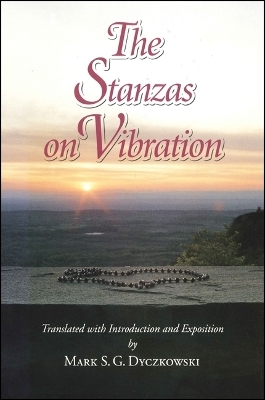
The Stanzas on Vibration
State University of New York Press (Verlag)
978-0-7914-1262-6 (ISBN)
In his Introduction and in his exposition of the four commentaries, the author shows both how the Spanda tradition contributes to the other schools of Kashmir Shaivism and how it is different from them. He presents for the first time a detailed treatment of this tradition and an analysis of its development. The aim is to offer a method that affords access by the general reader to the wonderful world of the Spanda Yogi through which she travels to the liberating realization of her authentic identity vibrant with the vitality of the universal pulse of Shiva.
Mark S. G. Dyczkowski took his first degree at Banaras Hindu University and then his doctorate at Oxford. He is presently associated with Sampurnananda Sanskrit University in Varanasi. He is the author of The Doctrine of Vibration: An Analysis of the Doctrine and Practices of Kashmir Shaivism; The Canon of the Saivagama and the Kubjika: Tantras of the Western Kaula Tradition; and The Aphorisms of Shiva: The Shiva Sutra with a Commentary by Bhaskara, all published by SUNY Press.
Preface
Acknowledgments
The Stanzas on Vibration
List of Abbreviations
Part I Introduction
Chapter 1. General Background
Chapter 2. The Beginnings of Kashmir Saivism
Chapter 3. The Origin of the Aphorisms of Siva
Chapter 4. Basic Features of the Stanzas on Vibration
Chapter 5. The Authorship of the Stanzas on Vibration
Chapter 6. The Commentators on the Stanzas on Vibration
Kallatabhatta
Rajanaka Rama
Bhagavadutpala
Bhaskara
Ksemaraja
Other Commentators and Commentaries
Chapter 7. The Doctrine of Vibration and Recognition
Pratyabhijna in the Commentary by Bhagavatdutpala
Recognition and the Pulse of Consciousness
Self Awareness, Own Being and Egoity .
Chapter 8. Spanda, Krama and Sakti : The Vibration of Consciousness and Its Power
Part II Commentaries and Exposition
Chapter 9. The Essence of Vibration, the SpandaSamdoha , by Ksemaraja
Chapter 10. The Stanzas on Vibration with the Brief Explanation, the Spanda Vrtti , by Kallatabhatta and the Extended Explanation, the Spanda Vivrti , by Rajanaka Rama
The First Flow called The Instruction Concerning the Tenability of (the Self's) Independent Existence
Stanza One
Stanza Two
Stanza Three
Stanza Four
Stanza Five
Stanza Six and Seven
Stanza Eight
Stanza Nine
Stanza Ten
Stanza Eleven
Stanza Twelve
Stanza Thirteen
Stanza Fourteen
Stanza Fifteen
Stanza Sixteen
The Second Flow called The Direct Perception of One's Own Independent Nature
Stanza Seventeen
Stanza Eighteen
Stanza Nineteen, Twenty, and Twenty-One
Stanza Twenty-Two
Stanza Twenty-Three and Twenty-Four
Stanza Twenty-Five
Stanza Twenty-Six and Twenty-Seven
The Third Flow called The Tenability of the Power of One's Own Universal Nature
Stanza Twenty-Eight, Twenty-Nine, and Thirty
The Fourth Flow called The Perception of Unity
Stanza Thirty-One
Stanza Thirty-Two
Stanza Thirty-Three and Thirty-Four
Stanza Thirty-Five
Stanza Thirty-Six and Thirty-Seven
Stanza Thirty-Eight
Stanza Thirty-Nine
Stanza Forty
Stanza Forty-One
Stanza Forty-Two
Stanza Forty-Three
Stanza Forty-Four
Stanza Forty-Five
Stanza Forty-Six
Stanza Forty-Seven
Stanza Forty-Eight
Stanza Forty-Nine and Fifty
Stanza Fifty-One
Stanza Fifty-Two
Condusion
Chapter 11. The Stanzas on Vibration with a Commentary called the Lamp of Spanda, the SpandaPradipika , by Bhagavadutpala
Introductory Verses
Stanza One
Stanza Two
Stanza Three
Stanza Four
Stanza Five
Stanza Six and Seven
Stanza Eight
Stanza Nine
Stanza Ten
Stanza Eleven
Stanza Twelve and Thirteen
Stanza Fourteen
Stanza Fifteen
Stanza Sixteen
Stanza Seventeen
Stanza Eighteen
Stanza Nineteen
Stanza Twenty
Stanza Twenty-One
Stanza Twenty-Two
Stanza Twenty-Three, Twenty-Four, and Twenty-Five
Stanza Twenty-Six
Stanza Twenty-Seven
Stanza Twenty-Eight and Twenty-Nine
Stanza Thirty
Stanza Thirty-One
Stanza Thirty-Two
Stanza Thirty-Three and Thirty-Four
Stanza Thirty-Five
Stanza Thirty-Six and Thirty-Seven
Stanza Thirty-Eight
Stanza Thirty-Nine
Stanza Forty
Stanza Forty-One
Stanza Forty-Two
Stanza Forty-Three
Stanza Forty-Four
Stanza Forty-Five
Stanza Forty-Six
Stanza Forty-Seven
Stanza Forty-Eight
Stanza Forty-Nine and Fifty
Stanza Fifty-One
Stanza Fifty-Two
Stanza Fifty-Three
Chapter 12. Exposition of the Stanzas
Stanza One
Stanza Two
Stanza Three
Stanza Four
Stanza Five
Stanza Six and Seven
Stanza Eight
Stanza Nine
Stanza Ten
Stanza Eleven
Stanza Twelve and Thirteen
Stanza Fourteen
Stanza Fifteen and Sixteen
Stanza Seventeen
Stanza Eighteen
Stanza Nineteen, Twenty, and Twenty-One
Stanza Twenty-Two
Stanza Twenty-Three, Twenty-Four, and Twenty-Five
Stanza Twenty-Six and Twenty-Seven
Stanza Twenty-Eight and Twenty-Nine
Stanza Thirty
Stanza Thirty-One
Stanza Thirty-Two
Stanza Thirty-Three, Thirty-Four, and Thirty-Five
Stanza Thirty-Six and Thirty-Seven
Stanza Thirty-Eight
Stanza Thirty-Nine
Stanza Forty
Stanza Forty-One
Stanza Forty-Two
Stanza Forty-Three
Stanza Forty-Four
Stanza Forty-Five, Forty-Six, and Forty-Seven
Stanza Forty-Eight
Stanza Forty-Nine and Fifty
Part III Aspects of Spanda Yoga
Chapter 13. The Means to Realization
Chapter 14. The Transition of the Moment and the Sixteen Phases of Perception
Chapter 15. The Principles of Passion, Pervasion, and the Stainless
Part IV Appendices
Appendix 1. The Sources
Appendix 2. Location of References to the Stanzas on Vibration
Appendix 3. The Sanskrit Text of the SpandaKarika
Notes
Bibliography
Index
| Erscheint lt. Verlag | 30.9.1992 |
|---|---|
| Reihe/Serie | SUNY series in the Shaiva Traditions of Kashmir |
| Einführung | Mark S. G. Dyczkowski |
| Übersetzer | Mark S. G. Dyczkowski |
| Zusatzinfo | Total Illustrations: 0 |
| Verlagsort | Albany, NY |
| Sprache | englisch |
| Maße | 152 x 229 mm |
| Gewicht | 789 g |
| Themenwelt | Geisteswissenschaften ► Religion / Theologie ► Hinduismus |
| ISBN-10 | 0-7914-1262-8 / 0791412628 |
| ISBN-13 | 978-0-7914-1262-6 / 9780791412626 |
| Zustand | Neuware |
| Haben Sie eine Frage zum Produkt? |
aus dem Bereich


